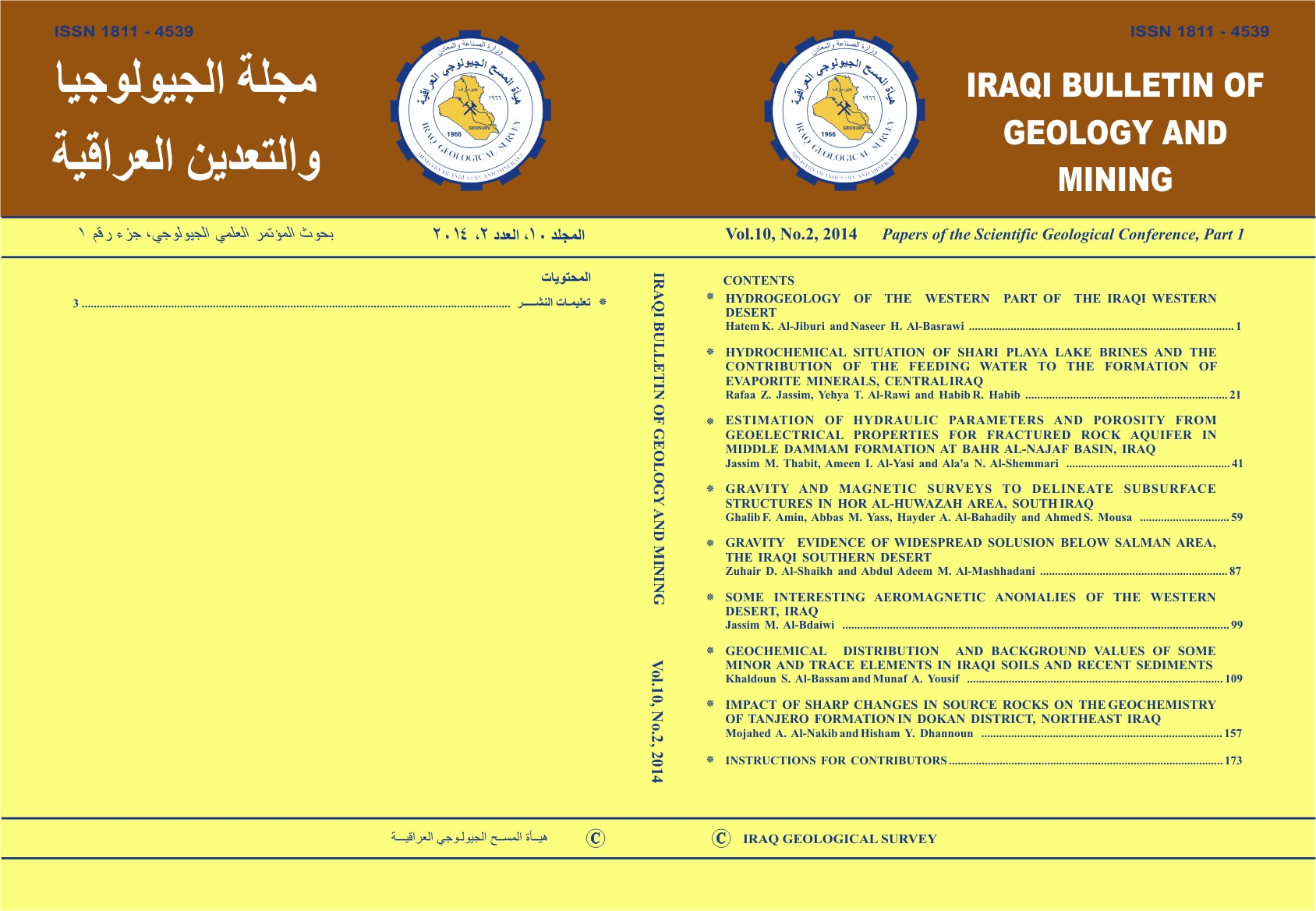Abstract
The western part of the Iraqi Western Desert is covered by carbonates, clastics and marl. The main aquifers in the region are within Suffi, Ga'ara, Mulussa, Muhaiwir, Ms'ad, Tayarat, Digma and Akashat formations. However, Nahr Umr, Rutbah and Ratga formations were either not recognized or not announced yet in the involved areas. Ga'ara aquifer is considered the most important one, on a regional scale due to its wide extent and large content of water. Most aquifers are recharged from rainfall and runoff of the intermittent wadis in form of leakage losses through permeable strata, fractures, fissures, joints and cavities into shallow aquifers. It is assumed that a hydraulic connection between aquifers exists to some extent. Leakage of water is either downwards or upwards, depending on piezometric relation of aquifers, lithology, structure and extent of water-bearing horizons.
The available updated hydrogeological information in the Hydrogeological Data Base indicates the presence of a water divide within the studied area, to the west of Rutbah town, with a general North – South trend. This water divide causes the groundwater to flow into opposite directions along its trend; accordingly, the general direction of the groundwater within the eastern part is towards east and northeast mainly, following the discharge zone along the right bank of the Euphrates River. While, at the western part of the studied area, the direction of the groundwater flow is towards the west; beyond the Iraqi borders. Locally, different directions of flow occur throughout the region, depending on the geological setting of water-bearing horizons and the nature of structure and topography. All the available previous studies have not mentioned the presence of this water divide within this part of the Western Desert, and always have, generally suggested that the direction of the groundwater flow is towards the east and northeast.
Salinity of the groundwater increases with depth and also towards discharge zones in general, but it ranges mainly from fresh to slightly brackish within the studied area. Water type varies and includes bicarbonate, chloridic and sulphatic water.
The available updated hydrogeological information in the Hydrogeological Data Base indicates the presence of a water divide within the studied area, to the west of Rutbah town, with a general North – South trend. This water divide causes the groundwater to flow into opposite directions along its trend; accordingly, the general direction of the groundwater within the eastern part is towards east and northeast mainly, following the discharge zone along the right bank of the Euphrates River. While, at the western part of the studied area, the direction of the groundwater flow is towards the west; beyond the Iraqi borders. Locally, different directions of flow occur throughout the region, depending on the geological setting of water-bearing horizons and the nature of structure and topography. All the available previous studies have not mentioned the presence of this water divide within this part of the Western Desert, and always have, generally suggested that the direction of the groundwater flow is towards the east and northeast.
Salinity of the groundwater increases with depth and also towards discharge zones in general, but it ranges mainly from fresh to slightly brackish within the studied area. Water type varies and includes bicarbonate, chloridic and sulphatic water.
Keywords
aquifer
hydrogeology
Iraq
Water divide
Western Desert
Abstract
تغطي الجزء الغربي من الصحراء الغربية العراقية الصخور الجيرية والفتاتية والطفل. إن الخزانات الجوفية الرئيسية في المنطقة تكون ضمن التكوينات الجيولوجية التالية: صوفي، گعرة، ملوصي، محيور، مسعد، طيارات، دگمة وعكاشات. ويعتبر الخزان الجوفي في تكوين گعرة الأكثر أهمية على النطاق الإقليمي ضمن المنطقة، وذلك لامتداده وكثرة المياه التي يحتويه. تكون تغذية غالبية الخزانات الجوفية المائية ضمن المنطقة من مياه الأمطار والوديان الموسمية المنتشرة في المنطقة، حيث تتسرب المياه وتتغلغل خلال الطبقات النفاذة وعن طريق الشقوق والتكسرات والتكهفات إلى الطبقات الحاملة للمياه. هنالك اتصال هيدروليكي بين الخزانات المائية ضمن عموم المنطقة، أي إن هنالك نضوح أو تسرب للمياه الجوفية من خزان جوفي إلى آخر، اعتماداً على مستوى المياه الجوفية والضغط البيزومتري لهذه المياه ضمن الطبقات الحاملة لها وعلى الطبيعة الصخارية لتلك الطبقات وامتداداتها وميلها.
أوضحت المعلومات الهيدروجيولوجية المتوفرة ضمن قاعدة البيانات الهيدروجيولوجية المحدثُة وجود مقسم مائي ضمن منطقة الدراسة يقع الى الغرب من مدينة الرطبة وبامتداد شمال – جنوب، على العموم. يؤدي هذا المقسم المائي الى ان يكون اتجاه حركة المياه الجوفية باتجاهين متعاكسين على طول امتداده، عليه فان اتجاه حركة المياه الجوفية ضمن الجزء الشرقي يكون باتجاه الشرق والشمال الشرقي، نحو منطقة التصريف على امتداد الضفة اليمنى لنهر الفرات. بينما في الجزء الغربي، يكون اتجاه حركة المياه الجوفية نحو الغرب خارج الحدود العراقية. هنالك اتجاهات موقعية أخرى قد تختلف عن الاتجاه العام، اعتماداً على الموقع الجيولوجي للتكوينات الحاملة للمياه والطبيعة التركيبية والطبوغرافية. لم تشر الدراسات السابقة كافة، الى وجود مثل هذا المقسم المائي ضمن هذه المنطقة من الصحراء الغربية، بل تشير دائما الى أن اتجاه حركة المياه الجوفية يكون عموما باتجاه الشرق والشمال الشرقي.
إن ملوحة المياه الجوفية تزداد مع العمق وباتجاه مناطق التصريف على العموم، ولكنها تتراوح في الغالب ما بين المياه العذبة وضعيفة الملوحة وذات نوعية مختلفة تشمل المياه البيكاربونايتية والكلوريدية والكبريتاتية.
أوضحت المعلومات الهيدروجيولوجية المتوفرة ضمن قاعدة البيانات الهيدروجيولوجية المحدثُة وجود مقسم مائي ضمن منطقة الدراسة يقع الى الغرب من مدينة الرطبة وبامتداد شمال – جنوب، على العموم. يؤدي هذا المقسم المائي الى ان يكون اتجاه حركة المياه الجوفية باتجاهين متعاكسين على طول امتداده، عليه فان اتجاه حركة المياه الجوفية ضمن الجزء الشرقي يكون باتجاه الشرق والشمال الشرقي، نحو منطقة التصريف على امتداد الضفة اليمنى لنهر الفرات. بينما في الجزء الغربي، يكون اتجاه حركة المياه الجوفية نحو الغرب خارج الحدود العراقية. هنالك اتجاهات موقعية أخرى قد تختلف عن الاتجاه العام، اعتماداً على الموقع الجيولوجي للتكوينات الحاملة للمياه والطبيعة التركيبية والطبوغرافية. لم تشر الدراسات السابقة كافة، الى وجود مثل هذا المقسم المائي ضمن هذه المنطقة من الصحراء الغربية، بل تشير دائما الى أن اتجاه حركة المياه الجوفية يكون عموما باتجاه الشرق والشمال الشرقي.
إن ملوحة المياه الجوفية تزداد مع العمق وباتجاه مناطق التصريف على العموم، ولكنها تتراوح في الغالب ما بين المياه العذبة وضعيفة الملوحة وذات نوعية مختلفة تشمل المياه البيكاربونايتية والكلوريدية والكبريتاتية.
